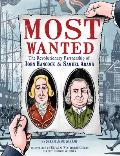This month brings a new picture book about Samuel Adams and John Hancock: Most Wanted, written by Sarah Jane Marsh and illustrated by Edwin Fotheringham.
That same team previously created Thomas Paine and the Dangerous Word. Fotheringham also illustrated Those Rebels, John and Tom, written by Barbara Kerley.
All these books are in the genre called “picture book biography,” which introduces kids in the early elementary-school grades to notable figures. The mode emphasizes lively storytelling and historical accuracy—which can be at odds, especially when subjects’ lives were not well detailed. (There’s ongoing debate in the field about just how accurate every detail must be.)
I’m highlighting Most Wanted: The Revolutionary Partnership of John Hancock and Samuel Adams because back in 2018 I had the pleasure of fact-checking the manuscript for the publisher. I’ve worked in publishing and even written for kids myself, so I can mix my nitpicky remarks about interpreting historical sources with some some realism about what’s feasible in a children’s book.
For instance, how to explain the Stamp Act in a picture book when it took me years to grasp it myself? And when a picture-book page contains one small paragraph of text? Most Wanted takes the editorial-cartoon approach, with Marsh explaining (in 35 words!) the purpose and scope of the law and Fotheringham sketching a giant sheet of stamped paper falling onto the colonists’ heads. Hancock’s comments on the law appear in italics to underscore how those words are documented to be his.
In fact, we checked all the quotes in the book. Marsh provided detailed source notes, and I dug further. Then a few months later I reviewed Fotheringham’s sketches and queries because he was just as concerned about depicting Hancock’s coach, wardrobe, natural hair, and other details correctly.
Most Wanted covers Adams and Hancock from the formation of their political partnership in the mid-1760s to their arrival at the Second Continental Congress ten years later. It describes the Stamp Act, the Liberty riot, the Massacre, and the Tea Party. But the climax of the book, taking up about a quarter of its 80 pages, is the drama of April 1775, as Hancock and Adams hole up in the parsonage at Lexington only to learn about redcoats marching their way. It’s therefore quite an appropriate book to share with young readers this month.

No comments:
Post a Comment